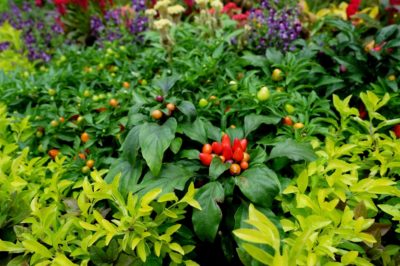Legumes
The legume family, Fabaceae, includes all peas and beans, and other legumes. There are about 19,000 plants in the family all together like lentils, clover, and even licorice. These plants share one very important trait. They have an ability to fix nitrogen from the air into the soil through a relationship with bacteria that lives at the plants’ roots.
Legumes are an excellent companion plant to peppers because of this characteristic combined with their timing. Peppers are a long season plant, and most peas or beans are short-season producers. You can get several harvests of legumes all in the time that a pepper takes to reach maturity. Mix it up and plant lettuce, radish, or beets in between legume harvests.
When you harvest the beans or lentils that you grow between your pepper plants, cut them off and leave the roots to decay in the ground. This is a huge source of nutrients for the pepper plants.
Herbs
Herbs serve several functions as companion plants in the garden. The potent volatile oils that make them fragrant are also typically disliked by pest insects and liked by beneficial insects. Attract predatory insects like ladybugs and praying mantis while also deterring pests like slugs and caterpillars.
Herbs also often enhance the flavor of peppers in culinary dishes, making them a great crop to have alongside a pepper harvest. Here are some excellent herbal pepper companions:
- Basil
- Garlic
- Oregano
- Dill
- Marjoram
- Parsley
- Rosemary
Flowers
Flower act much like herbs in their ability to attract the beneficial and deter the malevolent garden visitors. They have the added benefit of attracting pollinators, which vastly increases the productivity of pepper plants.
Geraniums are known to repel cabbage worms and Japanese beetles, petunias prevent damage from asparagus beetles and leafhoppers, and nasturtiums repel whiteflies, squash bugs, and aphids.
Vegetables
Other vegetables can also grow well with peppers. Onions and leeks are great for deterring pests and they don’t take up much room when planted between peppers. Lovage is a perennial celery that grows tall and can protect pepper plants from harsh mid-summer heat.
Plant peppers in the asparagus patch to utilize ground that otherwise is dormant during the summer months. Spinach, lettuce, and other leafy greens can shade out weeds around the base of pepper plants without competing for nutrients.
